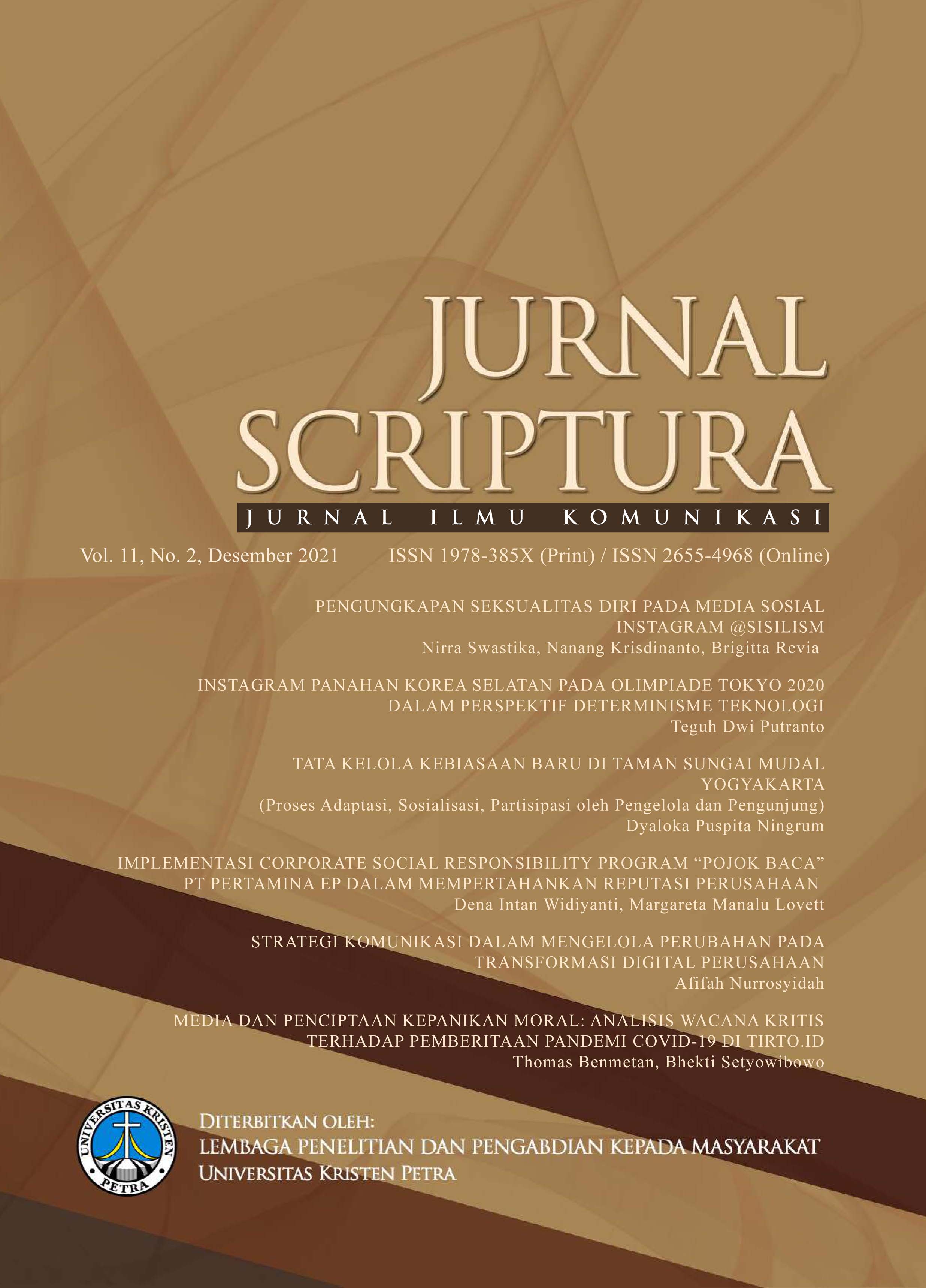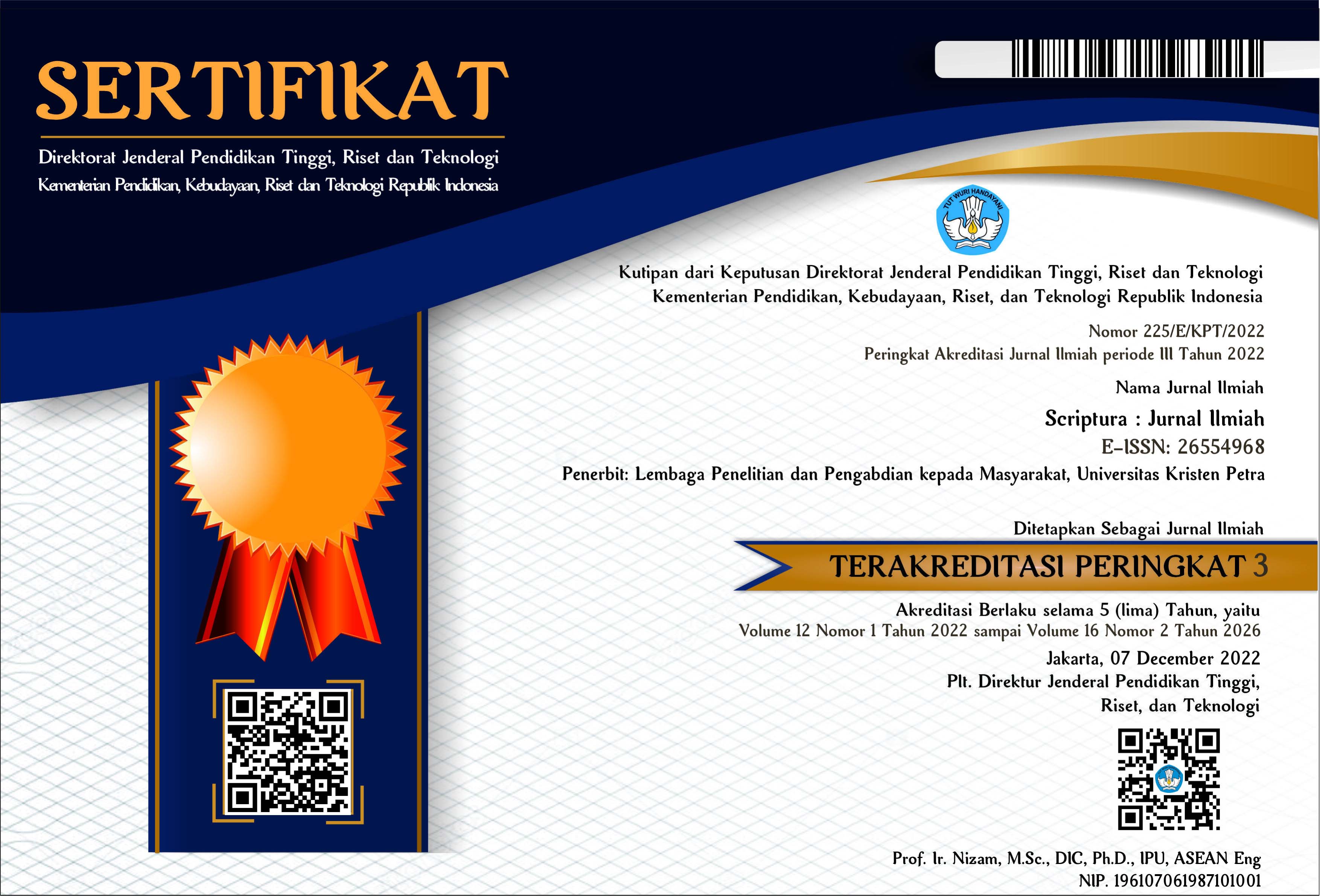STRATEGI KOMUNIKASI DALAM MENGELOLA PERUBAHAN PADA TRANSFORMASI DIGITAL PERUSAHAAN
 :
:
https://doi.org/10.9744/scriptura.11.2.96-104
Keywords:
Digitalisasi, transformasi digital, difusi inovasi, manajemen perubahanAbstract
Perkembangan teknologi mendorong perusahaan untuk melakukan transformasi digital. Hal ini dilakukan supaya perusahaan dapat bersaing di kancah global dan meningkatkan efisiensi dari proses bisnis yang dilakukan. Transformasi ini bisa berupa otomasi proses bisnis hingga implementasi tren teknologi seperti big data dan internet of things. Dalam implementasi inovasi digital, tidak semuanya berjalan mudah. Aspek organisasi dan kesiapan sumber daya manusia menjadi tantangan dan berisiko dalam kegagalan implementasi. Maka dari itu, diperlukan adanya manajemen perubahan dengan strategi komunikasi yang sesuai di setiap tahapannya sebagai kunci dari transformasi digital. Penelitian ini menggunakan metode kajian pustaka guna mengumpulkan informasi terkait dengan penelitian sebelumnya untuk pengelolaan perbahan yang diselaraskan dengan strategi komunikasi pada konsep difusi inovasi. Dari kajian tersebut, diperoleh tiga tahapan utama yang dapat diimplementasikan dalam pengelolaan perubahan antara lain tahapan edukasi, transformasi, dan evaluasi. Penyusunan manajemen risiko pun penting guna mendukung tahapan tersebut dan meminimalisir adanya penolakan dari sisi individu maupun kelompok.
References
Boschma, R. A. (2005). Proximity and innovation: A critical assessment. Regional Studies, 39(1), 61–74. https://doi.org/10.1080/0034340052000320 887
Brennen, J. S., & Kreiss, D. (2016). “Digitization” and “digitalization” are two conceptual terms that are closely associated and often used interchangeably in a broad range of literatures. This entry argues that there is analytical value in explicitly making a clear distinction between thes. The International Encyclopedia of Communication Theory and Philosophy, 1–11. https://doi.org/10.1002/9781118766804.wbiect111
By, R. T. (2005). Organisational change management: A critical review. Journal of Change Management, 5(4), 369–380. https://doi.org/10.1080/14697010500359250
Chou, H., Chang, H., Lin, Y., & Chou, S. (2014). Computers in Human Behavior Drivers and effects of post-implementation learning on ERP usage. Computers in Human Behavior, 35, 267–277. https://doi.org/10.1016/j.chb.2014.03.012
Dwivedi, Y. K., Wastell, D., Laumer, S., & Henriksen, H. Z. (2014). Research on information systems failures and successes : Status update and future directions. https://doi.org/10.1007/s10796-014-9500-y
Fiedler, S. (2010). Managing resistance in an organizational transformation: A case study from a mobile operator company. International Journal of Project Management, 28(4), 370–383. https://doi.org/10.1016/j.ijproman.2010.02.004
Gray, J., & Rumpe, B. (2015). Models for digitalization. Software and Systems Modeling, 14(4), 1319–1320. https://doi.org/10.1007/s10270-015-0494-9
Haines, S., Stead, A., & J, M. (2005). Enterprise Wide Change - Superior result through System Think-ing. Wiley.
Hall, B. H. (2009). Innovation and Diffusion. The Oxford Handbook of Innovation, January. https://doi.org/10.1093/oxfordhb/9780199286805.003.0017
Hubeis, Priono, M., S, S., A, S., A, B., Y, R., & Mien-tarti. (2007). Komunikasi Inovasi (2nd ed.). Universitas Terbuka.
Hultman, K. (2003). Resistance to Change, Managing. Encyclopedia of Information Systems. https://doi.org/Hultman, K. (2003). Resistance to Change, Managing. Encyclopedia of Information Systems, 693–705. doi:10.1016/b0-12-227240-4/00149-0
JP, K. (1996). Leading Change. Harvard Business School Press.
Kane, G. C., Palmer, D., Philips Nguyen, A., Kiron, D., & Buckley, N. (2015). Strategy, Not Tech¬nology, Drives Digital Transformation. MIT Sloan Management Review & Deloitte, 57181, 27. http://sloanreview.mit.edu/projects/strategy-drives-digital-transformation/
Kuusisto. (2017). Organizational effects of digitali-zation: A literature review. International Journal of Organization Theory & Behavior, 20(3), 341–362. https://doi.org/Kuusisto, M. (2017). Organi-zational effects of digitalization: A literature review. International Journal of Organization Theory & Behavior, 20(3), 341–362. doi:10. 1108/ijotb-20-03-2017-b003
Lauer, T. (2021). Success Factor Person: Right Leadership in Change. In Change Management. https://doi.org/10.1007/978-3-662-62187-5_6
Laumer, S., & Eckhardt, A. (2015). Why Do People Reject Technologies : A Review of User Resis-tance Theories Why Do People Reject Techno-logies : A Review of User Resistance Theories. September 2011. https://doi.org/10.1007/978-1-4419-6108-2
Lee, J.-C., Shiue, Y.-C., & Chen, C.-Y. (2016). Examining the impacts of organizational culture an top management support of knowledge sharing on the success of software process improvement. Computers in Human Behavior.
Lewin, K. (1976). Field Theory in Social Science. Harper & Row.
Linton, J. (1998). Diffusion of innovations. In Circuits Assembly (Vol. 9, Issue 4). Free Press. https://doi.org/10.4337/9781800883284.diffusion.of.innovations
Mahajan, V. (2004). Innovation diffusion. Technology Review, 107(10), 18.
Markee, N. (1992). The Diffusion of Innovation in Language Teaching. Annual Review of Applied Linguistics, 13, 229–243. https://doi.org/10. 1017/s0267190500002488
Markus, M. L. (2004). Technochange management: Using IT to drive organizational change. Journal of Information Technology, 19(1), 4–20. https://doi.org/10.1057/palgrave.jit.2000002
McCabe, D. (2020). Changing Change Management. Changing Change Management, July. https:// doi.org/10.4324/9780429029981
Meade, N., & Islam, T. (2006). Modelling and fore-casting the diffusion of innovation - A 25-year review. International Journal of Forecasting, 22(3), 519–545. https://doi.org/10.1016/j.ijfore-cast.2006.01.005
Mukti, D. P., & Dudija, N. (2016). Organizational Change Dynamics : A Learning Organization Process toward World Class Organization. Isclo, 69–78. https://doi.org/10.2991/isclo-15. 2016.15
Nwankpa, J. K. (2015). Computers in Human Behavior ERP system usage and benefit : A model of antecedents and outcomes. 45, 335–337.
Ostmeier, E., & Strobel, M. (2022). Building skills in the context of digital transformation: How industry digital maturity drives proactive skill development. Journal of Business Research, 139(January 2020), 718–730. https://doi.org/10. 1016/j.jbusres.2021.09.020
Paton A, R., & McCalman, J. (2008). Change Management: A Guide to Effective Implementation (Third Edit). SAGE.
Rogers, B. E., & Dunkerley, D. (2016). CRISC: Certified in Risk and Information Systems Control. McGraw-Hill Education.
Rogers, D. L. (2016). The digital transformation playbook : rethink your business for the digital age. Columbia University Press.
Rogers, E. M. (1983). Diffusion of Innovation.
Rushendi, Sarwititi Sarwoprasdjo, R. S. H. (2016). Influence of Interpersonal Communication Me-dia on Adoption Decision of the Integrated Citronella–Livestock Bio-industry Farming Innovation in West Java Province. 34(2), 135–144.
Seemann, K. (2003). Basic principles in holistic technology education. Journal of Technology Education, 14(2), 28–39. https://doi.org/10. 21061/jte.v14i2.a.3
Shang, S., & Seddon, P. B. (2002). perspective. 2000, 271–299.
Spafford, G. (2013). Know the Top Five Reasons Why New Change Management Implementations Fail and How to Avoid Failure.
Sumardjo. (2016). Pengertian Komunikasi Inovasi. Komunikasi Inovasi, Sumardjo 2014, 1–60.
Suuronen, S., Ukko, J., Eskola, R., Semken, R. S., & Rantanen, H. (2022). A systematic literature review for digital business ecosystems in the manufacturing industry: Prerequisites, challenges, and benefits. CIRP Journal of Manufacturing Science and Technology, 37, 414–426. https://doi.org/10.1016/j.cirpj.2022.02.016
Turner, D. M., Hallencreutz, J., & Haley, H. (2009). Leveraging the value of an organizational change management methodology. International Journal of Knowledge, Culture and Change Management, 9(9), 25–34. https://doi.org/10.18848/1447-9524/cgp/v09i09/49802
Veile, J. W., Schmidt, M. C., & Voigt, K. I. (2022). Toward a new era of cooperation: How industrial digital platforms transform business models in Industry 4.0. Journal of Business Research, 143(November 2021), 387–405. https://doi.org/10.1016/j.jbusres.2021.11.062
W, B., & S, B. (2009). Managing Transitions: Making the Most of Change. Da Capo Lifelong Books.
Webster, J., & Watson, R. T. (2002). Analyzing the Past to Prepare for the Future : Writing a Literature Review Analyzing The Past To Prepare For The Future : Writing A. 26(2).
Wibowo. (2006). Managing Change: Pengantar Manajemen Perubahan. Penerbit Alfabeta.
Winardi. (2006). Manajemen Perubahan. Kencana Prenada Media Group.
Downloads
Published
How to Cite
Issue
Section
License
Copyright (c) 2021 Jokhanan Kristiyono, Nurrosyidah

This work is licensed under a Creative Commons Attribution 4.0 International License.
Authors who publish in the SCRIPTURA Jurnal Ilmiah agree to the following terms:
Authors retain unrestricted copyright and full publishing rights. The authors grant the Publisher the right of first publication, with the work simultaneously licensed under the terms and conditions of the Creative Commons Attribution License (CC BY) that allows for unlimited use, distribution, and content reproduction on all media as long as the original author and source are properly acknowledged and cited.


















